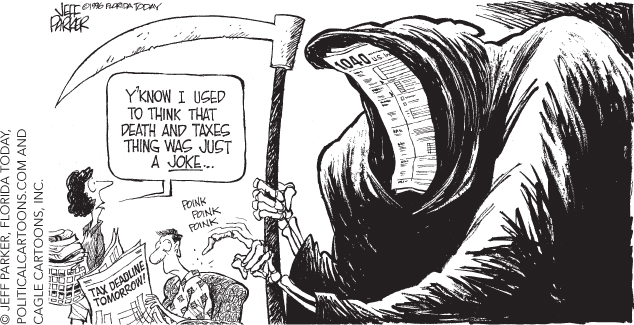6 Taxes and Subsides
95
CHAPTER OUTLINE
Commodity Taxes
Who Ultimately Pays the Tax Does Not Depend on Who Writes the Check
Who Ultimately Pays the Tax Depends on the Relative Elasticities of Supply and Demand
A Commodity Tax Raises Revenue and Creates a Deadweight Loss (Reduces the Gains from Trade)
Subsidies
Takeaway
“If you’re super-wealthy, it’s a good year to die,” so argued one estate planner in 2010. In 2010, the U.S. estate tax temporarily disappeared, giving the very wealthy a big tax break, so long as they died. George Steinbrenner was one billionaire who timed it right. The owner of the New York Yankees, worth an estimated $1.1 billion, died in 2010, leaving the IRS next to nothing. If Steinbrenner had died in 2009 or 2011, he would have likely owed about $500 million.
The temporarily disappearing estate tax created some peculiar incentives. In 2009, it paid to keep wealthy grandma on life support until at least January 1, 2010, but in 2010, it was financially better to pull the plug. Could financial incentives really make a difference in when people die? In fact, two economists, Joshua Gans and Andrew Leigh, found that in Australia a potential $10,000 reduction in the estate tax postponed death by about a week! If that sounds incredible, it may help to know that there is also a small but noticeable trend for people to live until after their birthdays or other major events. New York hospitals, for example, reported fewer deaths than usual in the last week of 1999—the last week of the twentieth century—and more deaths than usual in the first week of the twenty-first century. If death can be postponed for major events, then why not postpone death to save on taxes? Or if that fails, don’t call the coroner until the lower tax rate is in effect.
If all this seems a bit macabre, don’t worry—not only can deaths be postponed for tax reasons, births can also be advanced. Parents get a tax deduction for dependents like children, and so long as the child is born before the clock strikes midnight on December 31, the family gets the deduction for the entire year. Thus, compared with a child born in early January, a child born in late December can save parents thousands of dollars. Journalist David Leonhardt wrote about this incentive in The New York Times:
96
Unless you’re a cynic, or an economist, I realize you might have trouble believing that the intricacies of the nation’s tax code would impinge on something as sacred as the birth of a child. But it appears that you would be wrong.

Not only are more children born in late December than in early January, but also the extra births appear to be clustered among those who have the most to gain from a tax deduction, exactly as a cynic or an economist would predict. Leonhardt coined the term “national birth day” to indicate the day of the year on which the largest number of births occurs. For a long time, “national birth day” was around mid-September (probably because it was cold and dark the previous December!). But amazingly, as induced labor, Caesarian sections, and taxes have all increased, the day of the year on which the largest number of births occur has now moved to late December!1
In this chapter, we examine taxes and also subsidies, which are payments from the government for production. The analysis will draw on our understanding of demand and supply and also on our understanding of elasticity from the last chapter.